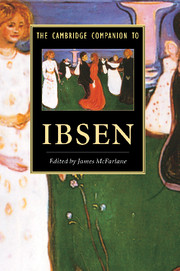Book contents
- Frontmatter
- 1 Ibsen's dramatic apprenticeship
- 2 Ibsen and historical drama
- 3 Dramatic and non-dramatic poetry
- 4 Ibsen and comedy
- 5 Ibsen and the realistic problem drama
- 6 Ibsen and feminism
- 7 The middle plays
- 8 The last plays
- 9 Ibsen's working methods
- 10 Ibsen and the theatre 1877-1900
- 11 Ibsen and the twentieth-century stage
- 12 Ibsen on film and television
- 13 On staging Ibsen
- 14 Ibsen and the drama of today
- 15 A century of Ibsen criticism
- 16 Works of reference
- Index
13 - On staging Ibsen
Published online by Cambridge University Press: 28 May 2006
- Frontmatter
- 1 Ibsen's dramatic apprenticeship
- 2 Ibsen and historical drama
- 3 Dramatic and non-dramatic poetry
- 4 Ibsen and comedy
- 5 Ibsen and the realistic problem drama
- 6 Ibsen and feminism
- 7 The middle plays
- 8 The last plays
- 9 Ibsen's working methods
- 10 Ibsen and the theatre 1877-1900
- 11 Ibsen and the twentieth-century stage
- 12 Ibsen on film and television
- 13 On staging Ibsen
- 14 Ibsen and the drama of today
- 15 A century of Ibsen criticism
- 16 Works of reference
- Index
Summary
INTERVIEW BY JANET GARTON
JG: You have produced three Ibsen plays, one realistic, one historical and one poetic: Pillars of the Community with the Royal Shakespeare Company in 1977, The Vikings at Helgeland in Bergen in 1983, and Peer Gynt in Oslo in 1990. Why these three plays?
JB: It is a peculiar selection and it doesn't necessarily represent my interest in Ibsen. In general I think I tend to go for the flawed masterpiece or the early play or the undiscovered play, more often than not. So there is a certain common ground here, though it might not seem so. In the case of all the Ibsen plays I have done, either I was asked to or I chose to or I was required to adapt in some way, and this is something I always find myself drawn to. Pillars of the Community was the first major production outside Shakespeare that I had ever done at that time for the RSC. I pushed for it because I thought it was a potentially wonderful play. It is one of those plays that has to have a good group cast and there was a very good group available. I was also fascinated by all the problems of how to bring off the ending. I suppose on the surface it is like certain Elizabethan plays: it's plain sailing for four Acts and then goes crazy at the end. So there were resemblances.
- Type
- Chapter
- Information
- The Cambridge Companion to Ibsen , pp. 217 - 226Publisher: Cambridge University PressPrint publication year: 1994

